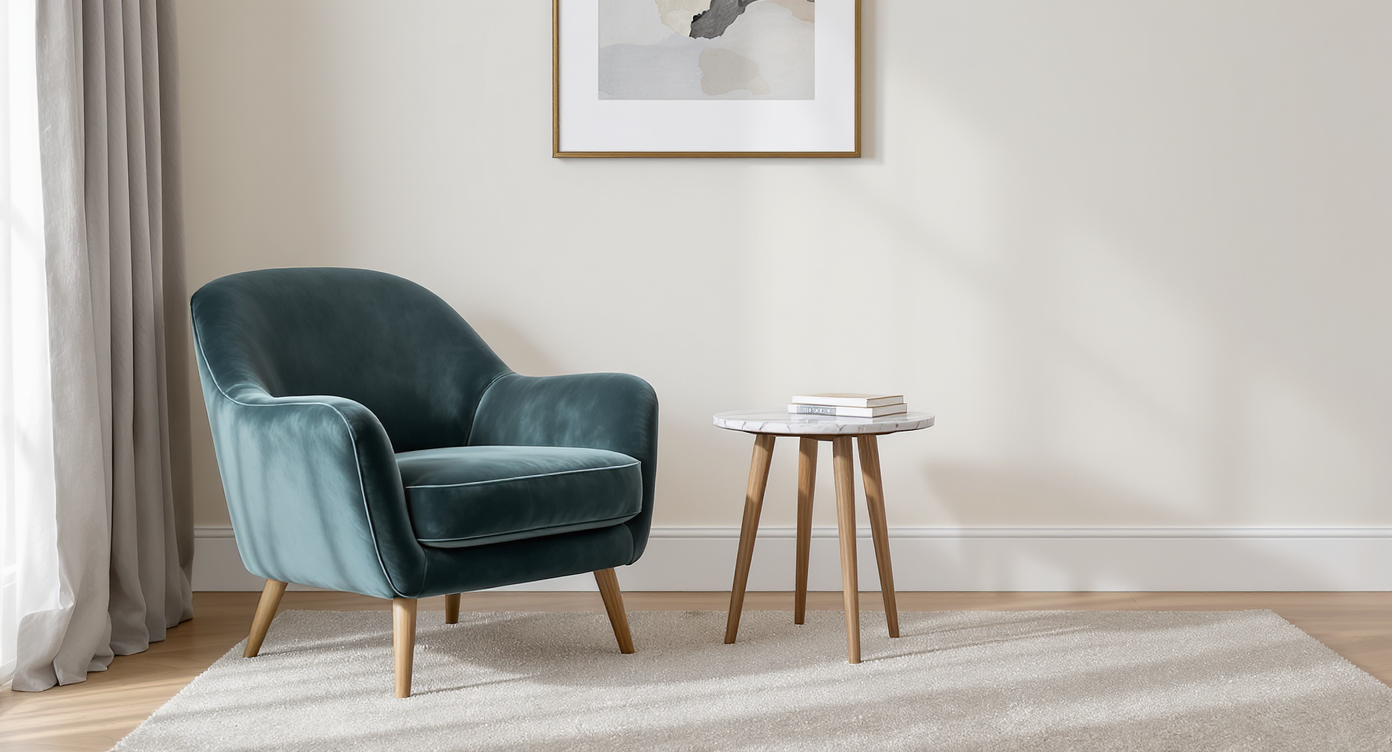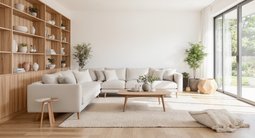TL;DR
Measure first, then style: prioritize clearances, scale, and ergonomics before picking a look. This guide covers sofa size, dining table dimensions, and materials that last, plus how to choose dining table size for 6 and mix styles without clashing.
Opening Context & Promise

Small-scale furniture with balanced textures enhances room flow and style harmony in tight spaces.
Here’s the thing: most furniture mistakes come from two places—buying by eye (not tape measure) and chasing trends without a plan. The result is a sofa that swallows the living room, a dining table that elbows the walkway, or a “statement” piece that doesn’t play well with the rest. What most people miss is that function unlocks style. When you dial in clearances, seat heights, and surface sizes, the room starts to breathe. Then you layer in a style palette you’ll still love in five years. Promise: a simple framework to choose furniture that fits your room envelope, a sofa size that supports your body, a dining table size that truly seats your family, and materials that stand up to daily life—without giving up personality. A carved creature-base coffee table once split a room of friends; swapping to a round top and moving it to a plant-filled corner turned “ugly-cute” into showpiece. Fit first, then flourish.
Core Question: What Furniture Fits My Room?
Core Question: What Furniture Fits My Room?
Start with walkable clearances, human-scaled ergonomics, and a layout that keeps 30–36 in pathways and at least 18 in of knee space where you sit. Right-size pieces to the room envelope, then test the flow before you buy.
Quick check: measure the full room L×W, note door swings, windows, radiators, outlets, and vents. Tape out big pieces on the floor—sofa length, dining table footprint, bed frame plus nightstands—to see if you still keep those 30–36 in circulation lanes.
- Walkways: 30–36 in clear is comfortable; 24 in minimum in tight spots.
- Coffee table to sofa: 14–18 in for reach and legroom.
- Sofa ergonomics: seat height 17–19 in; seat depth 20–24 in (taller folks prefer 22–24 in).
- Dining: table height 28–30 in; chair seat 17–19 in; allow 24 in width per diner; keep 36 in circulation around the table.
- Bed clearances: 24–30 in on each side; nightstand top within 2–3 in of mattress height.
- TV setup: viewing distance ≈ 1.5–2.5× screen diagonal; mount so the center is at seated eye level.
Micro-anecdote: a 72 in sofa felt huge in a 10×12 room until we floated it 6 in off the wall, centered a 48×24 in coffee table 16 in away, and carved a 32 in path to the balcony. Scale plus spacing made it feel intentional, not cramped.
Anecdote
A 72-inch sofa overwhelmed a 10×12 living room until we floated it 6 inches off the wall and kept a 32-inch path to the balcony—instant breathing room.
Style Selector: How Do I Pick a Furniture Style I’ll Still Love in 5 Years?
Anchor your home with one primary style (about 70%) and one supporting style (about 30%) for layered cohesion. Choose shapes, wood tones, and fabrics that echo each other, then add one conversation piece for personality.
- Mid-Century: clean lines, tapered legs, walnut/teak, tufting, low-slung sofas. Pairs well with Scandinavian.
- Scandinavian/Japandi: light woods, matte finishes, linen/cotton, rounded edges, negative space. Calm, airy, ergonomic.
- Transitional: classic silhouettes simplified; neutral fabrics; brushed hardware. Bridge between traditional and contemporary.
- Contemporary: sleek profiles, mixed materials, thin arms, metal accents. Prioritize scale and comfort to avoid sterility.
- Industrial: blackened metals, reclaimed woods, visible joinery. Balance with soft rugs and upholstery.
- Traditional: rolled arms, turned legs, rich woods, patterned textiles. Edit details for modern livability.
- Coastal: slipcovers, light oaks, woven textures, blues/sands. Performance fabrics are your friend.
- Boho: eclectic mixes, rattan, kilims, carved pieces. Ground with a neutral sofa so the mix reads curated.
Decision tip: love a quirky base table or sculptural chair? Let it be the star, but tie it in with one repeated element—matching wood tone, rounded forms, or a shared metal finish—so it feels collected, not chaotic. Think “mid-century vs Scandinavian furniture differences” in lines and woods, not a total mashup.
Micro-anecdote: a whimsical creature-base table read “odd” until we swapped the odd-shaped glass for a 30–34 in round top that echoed nearby drum stools. Same art piece, new harmony.
Materials & Finishes: What Holds Up and Looks Good?
Durability comes from construction first, finish second. Prioritize solid frames, quality suspension, and easy-care textiles before you fall for a fabric swatch or glossy lacquer.
- Sofas: kiln-dried hardwood frames; sinuous or 8-way hand-tied springs; performance fabric with >15,000 double rubs (30,000+ for family rooms). Feather-wrapped foam blends softness with structure.
- Tables: solid wood can be refinished; good veneer (≥0.6 mm) is stable and lighter. Oil finishes feel natural but need care; lacquer resists spills. Use coasters to avoid heat and water rings.
- Rugs: wool is resilient and self-cleans; synthetics (polypropylene/olefin) excel in spill zones; flatweave for doors and low-clearance areas. For bedrooms, run the rug 24 in beyond bed sides for warm landings.
- Metals: unlacquered brass will patina; powder-coated steel/aluminum resists chips better than sprayed paint in high-traffic pieces.
- Leather: full-grain ages beautifully; top-grain is durable and budget-friendlier; avoid bonded leather for longevity.
Quotable fact: Performance fabrics with 30,000–50,000 double rubs stand up to daily family-room use without looking tired.
Room-by-Room Buying Guide
Prioritize anchor pieces first—sofa, dining table, bed frame, desk—then layer storage, lighting, and accent tables. Fit, comfort, and finish on anchors matter more than trend pieces.
Living Room
Choose sofa length based on room width and keep 30–36 in paths around it; avoid sectionals that block doorways. Slim arms reduce visual weight; nesting coffee/side tables flex for tight layouts.
- Best sofa size: in a 10×12 room, 72–80 in sofas leave circulation; float if needed.
- Coffee table height ≈ 16–18 in; length ~ two-thirds the sofa.
- Avoid this: overscale pillow arms, too-tall coffee tables, and side tables deeper than the walkway.
Dining
Allow 24 in per diner and 36 in circulation around the dining table. Rectangle works for long rooms; round or oval softens tight corners and keeps knees happy—pedestal bases maximize legroom.
- How to choose dining table size for 6: aim ~36×72 in rectangle or 54–60 in round.
- Rug sizing: extend the rug 24 in past the table on all sides.
- Chandelier height: hang 30–34 in above the tabletop.
- Avoid this: chunky trestle legs with armless chairs in small rooms; you’ll bump knees.
Bedroom
Match bed size to room size for smooth flow: queens fit 10×10 nicely; kings feel better in 12×12+. Keep 24–30 in clear on each side; nightstands within 2–3 in of mattress height.
- Place dressers with 30 in clearance to open drawers comfortably.
- Rug size guide: for a queen, 8×10 usually gives the 24 in perimeter you want.
- Avoid this: tall footboards in short rooms—they visually shorten the space.
Workspace
Desks should be 24–30 in deep for screens and papers; pick an ergonomic chair with 17–21 in adjustable seat height. Target 300–500 lux task lighting at the work surface.
- Cable access near outlets keeps tops clean and productive.
- Avoid this: shallow 18 in writing desks for dual-monitor setups.
Micro-anecdote: a 9×11 dining nook felt cramped with a 36×72 in rectangle. Swapping to a 54 in round pedestal preserved 36 in circulation and made weeknight dinners feel relaxed.
Visualization Scenario
Test a 54-inch round pedestal table versus a 36×72 rectangle in a 9×11 dining nook; verify the 36-inch circulation and chandelier height at 30–34 inches.
FAQ
How do I choose the right sofa size for my living room?
Keep 30–36 in walkways and place the coffee table 14–18 in from the sofa. In small living rooms, a 72–80 in sofa with slim arms feels generous without crowding.
What’s the best dining table size for 4, 6, or 8 people?
Allow 24 in per diner: 4 people ≈ 36–42 in round or 30×48 in; 6 people ≈ 54–60 in round or 36×72 in; 8 people ≈ 42–48 in × 84–96 in.
Which furniture styles mix well without clashing?
Pair a 70% primary style with a 30% supporting style—Mid-Century with Scandinavian, Contemporary with Transitional. Repeat one element (wood tone, leg shape, or metal) to unify.
What rug size works with a sectional sofa?
Choose a rug large enough to tuck at least the front legs of all seating; with a sectional, 8×10 or 9×12 often works. Maintain 18 in of bare floor at room edges.
How do I compare performance fabric vs natural linen?
Performance fabric (poly blends) offers stain resistance and >15k–30k double rubs; linen breathes and softens but wrinkles and needs gentler care. Use performance in high-traffic zones.
What clearance do I need around a bed and dresser?
Keep 24–30 in beside the bed and 30 in in front of dressers for drawer access. Nightstands should be within 2–3 in of mattress height for comfort.
Closing Thoughts
Comfort, longevity, joy—when furniture respects your body and your floor plan, style becomes the easy part. Choose fewer, better pieces: a sofa with supportive seat depth, a dining table that truly fits 6, a rug that lands under every chair, a statement accent that makes you smile every day. Test your layout digitally, try finishes against your actual light, and confirm clearances before you swipe your card. Want to see your sofa size, dining table dimensions, or that quirky conversation piece in your real room? Upload a photo and experiment with layouts, finishes, and styles in minutes with ReimagineHome. Visualize first, buy once, love it longer.
.svg)

.svg)
.jpg)






.png)